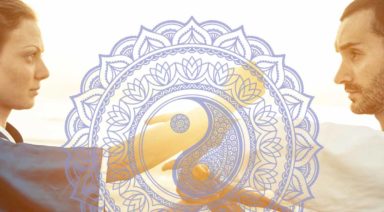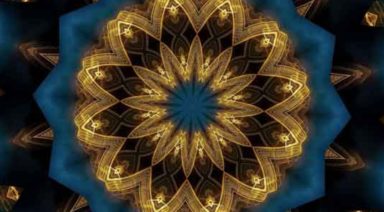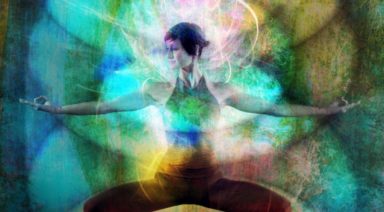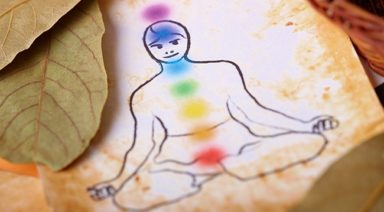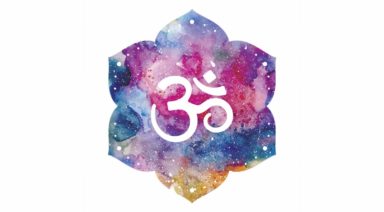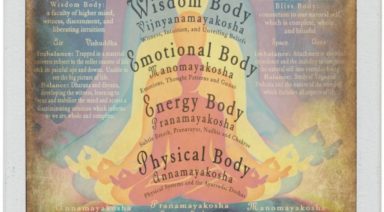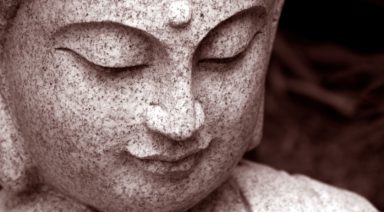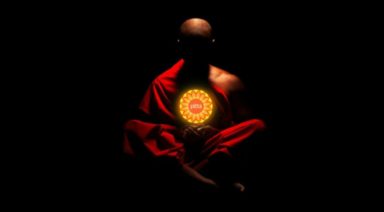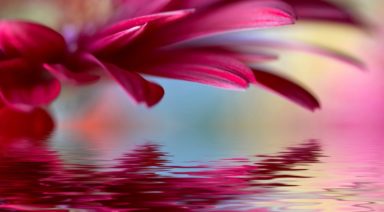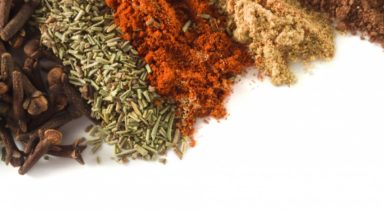Flowing Through the Throat Chakra with Saraswati

A while back I finally had my Vedic astrology chart done and was informed I had the goddess Saraswati in my chart as well as the lord Hanuman. I love to sing and chant in my classes and lead Kirtan, so this all made sense to me because Hanuman loves to fly and was known for his love of singing. Meanwhile, Saraswati rules the throat chakra and is the goddess of music, clear speech, knowledge, and communication—things I’m always striving towards.
Leading a retreat in Bali, I had been drawn to statues and images of Saraswati and brought some home. I realized that my own need to balance my throat chakra through chanting was an aspect of Saraswati in me. And if you’re ever in need of speaking your truth or communicating more clearly, invoking the essence of Saraswati can be very helpful.
Saraswati and the Sound of Om
At the beginning of everything, when the Universe was a swirling mass of nothing and everything, Brahma stood staring at the chaos. Brahma, of the Holy Trinity of Brahma, Vishnu, and Shiva, was well-known as the Creator and representative of brighter, new beginnings. He stood scratching one of his four heads in confusion. He wasn’t sure how to get started with his task of creating something of a Universe out of a gurgling, swirling, bubbling mass of chaotic energy. Saraswati, who was Brahma’s wife at the time, saw Brahma’s confusion, so she decided to help in her own way.
Brahma heard the sound of a great rushing cascade of water, but looked around and saw nothing. It was from the depths of his being where the water moved and flowed through his throat. A great waterfall poured out of his mouth, and with the waterfall came Saraswati.
She was fascinating and beautiful to behold. Her skin as luminous as the moonlight, her hair as black as night with no moon. She held a stringed instrument in her arms and began playing. And with her music, she spoke. She told Brahma she would give him one sound, which he was to use to create order from chaos. The sound held three syllables: A, U, and M.
The three syllables represent beginnings, middles, and endings, just like the Holy Trinity. When chanted these syllables would set the stage for everything to be born, live, and die. Brahma took a comfortable seat and began to chant over and over the sound of OM. The sound took hold of nothing and began to create everything.
Saraswati and the Throat Chakra
Whether you’re rocking out to Slayer in your car, or sitting in a yoga class chanting, you’re using and moving good energy through your throat chakra.
The name of the throat chakra or fifth chakra is the Vishuddha Chakra, or the purity energy center. This energy center is where we connect to truthful speech and clear communication. If this area is blocked, we experience throat and mouth problems as well as insecurities, indecision, and creative blocks.
Saraswati’s essence corresponds with the throat chakra. If we are ever in need of speaking our truth, committing to our spoken boundaries, or expressing dialogue more clearly, chant. And, yes, a Saraswati mantra is helpful for invoking Saraswati, but I also believe any time you’re singing or chanting you’re invoking Saraswati no matter what. To get specific and focused on evoking Saraswati, chant the following a few times, or 108 times to be precise!
OM AIM SARASWATIYEY NAMAHA
Saraswati and the Water Element
One translation of ‘Saras’ in Saraswati’s name is ‘flow.’ Saraswati’s essence tied to the water element shows up in the flow of creativity and the flow of clear, truthful words from our mouths. She is also the flow of knowledge and how we express it into the world.
Looking at the water in a river or a creek, notice first the water itself. Then you may notice some branches and rocks, or even a fallen tree. What is evident about water as it traverses the course, is it is always malleable. Water inherently knows how to go with the flow. And most importantly, as the water makes its way around the different obstacles, it never loses a sense of its essence. It knows how to be true to its own essence.
Saraswati’s water essence is our thirst for knowledge, the knowledge which creates order out of chaos. It’s how we learn to step into the flow of the impermanence of it all. Without losing a sense of who we are and what we stand for.
Saraswati and the Peacock
Saraswati’s animals are usually the peacock and the swan. The swan is all white, much like Saraswati’s garments. The white represents purity in the quest for wisdom and artistry. And because Saraswati is commonly seen sitting with swans and peacocks playing her instruments, she is also relevant when we speak of Bhakti Yoga.
The peacock is Saraswati’s main choice for getting around. The peacock is beautiful, brave, and a risk-taker. When a peacock is intent on wooing a peahen, it spreads its tail feathers out big and wide. This puts the peacock at risk of being harmed by any predators because it inhibits the peacock’s ability to see on its periphery. The peacock presents itself to the peahen but has to put itself at risk to do so, but to him, it’s worth it.
We learn that evolving on our path is sometimes risky. We need to put ourselves out there (spread our tail feathers) even if we feel some people may not agree. We learn to say ‘no’ with conviction and stay true to our spoken boundaries. We stop living in the ‘shoulds’ (stop should-ing on yourself) and start moving towards our dreams and goals. We gain knowledge and start to recognize what’s important to our individual self on our individual path, and Saraswati helps us speak with passion, conviction, and wisdom.
Lalitha Invites Beauty and Play Through Sugarcane Pose

I’m sure at some point in your yoga journey you have unknowingly experienced Sugarcane Pose. Sugarcane pose’s English translation is rarely used. Instead, it is referred to as Ardha Chandra Chapasana, or just Chapasana. It is a standing backbend version of Half Moon Pose (Ardha Chandrasana). Ardha means ‘half,’ Chandra means ‘moon,’ Chap means ‘bow,’ and Asana means ‘pose’.
I’m half Filipina and I was lucky to have a father working for the U.S. government who was interested in working in Southeast Asia because he is Filipino, so I lived there until the age of 17. Whether we were in Taipei, Seoul, Manila or Jakarta, there would always be a street stand selling raw sugarcane.
As a result, I grew up gnawing on sugarcane husks, relishing in the flavor of the sugary sweet juice and the texture of the dense, fibrous cane. When I heard the name sugarcane pose and discovered that Lalitha was sometimes referred to as the Sugarcane Goddess, I felt very connected to both the pose and the goddess and wanted to know more.
Lalitha’s Depiction
One translation of Lalitha’s name is ‘she who plays.’ When we invite the essence of Lalitha into our lives, we are inviting spontaneity, playfulness, and joy into our lives. She is a form of Shakti Devi, the auspicious feminine energy relevant to the Universe or Source. She represents beauty, and her depiction conveys that.
Lalitha is usually seen seated on a lotus flower which guides us toward fulfilling our desires. She has long, black, gorgeous hair that smells like flowers, and a slight red tinge to her skin tone.
Her skin color is beautiful and represents the color of the first dawn or the hopefulness of new beginnings, and she is sometimes referred to as the Red Flower Goddess. She has four arms and a crescent moon adorns her forehead. In her hands, she holds a bow of sugarcane, five arrows made of flowers, a farming instrument for rounding up cattle (a goad), and a noose. The goad and noose represent our ability to develop an aversion (goad) to attachment (noose) and eventually find true joy.





